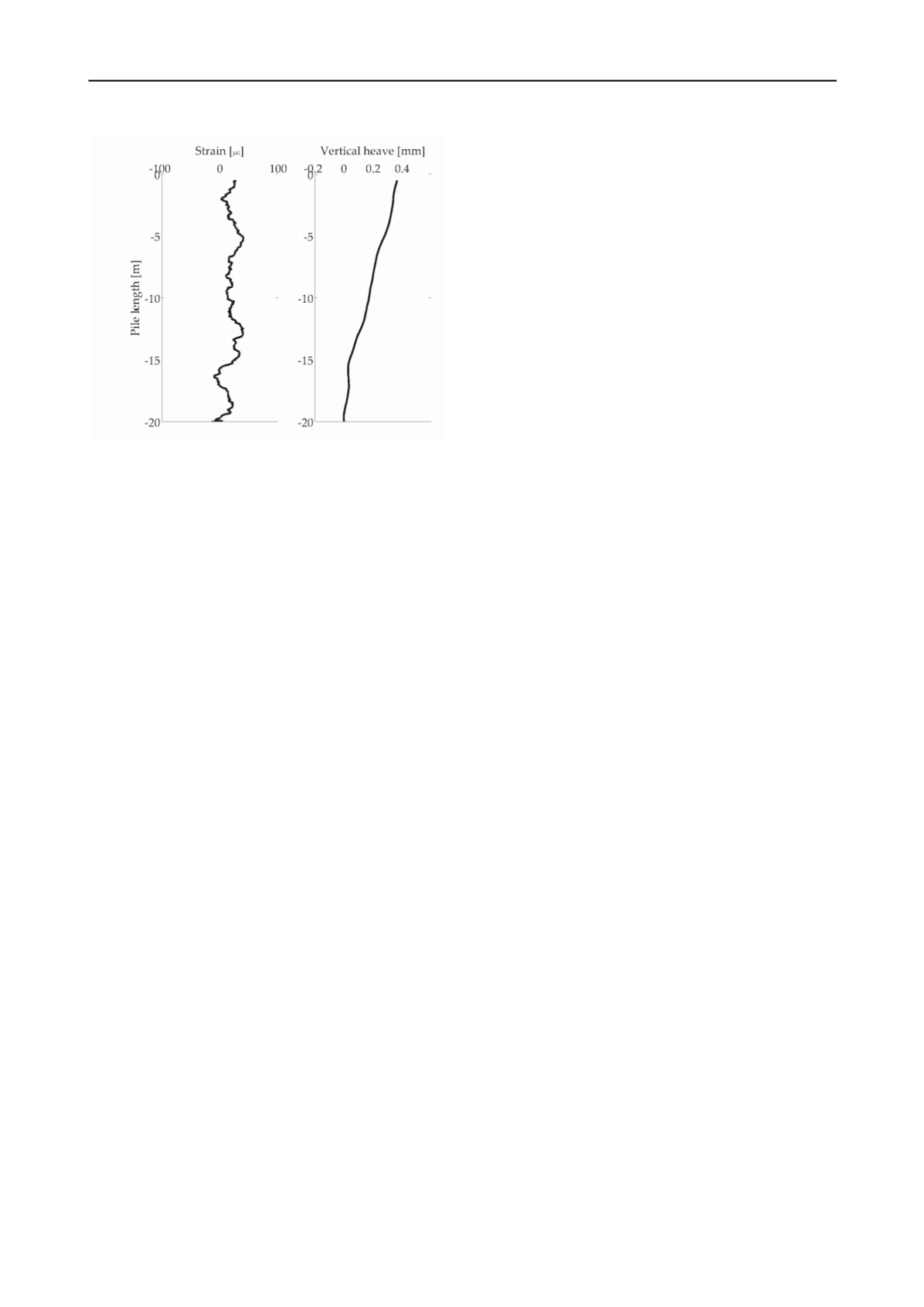
1866
Proceedings of the 18t
h
International Conference on Soil Mechanics and Geotechnical Engineering, Paris 2013
Figure 6. Strain profile along the borehole with interpreted ground
heave profile.
3.3 Discussion
The magnitude of vertical movement measured from pile E47
during the demolition is smaller than 1mm. The resulting force
generated at the top section of the pile is estimated to be around
3,
800 kN by assuming the pile Young’s modulus is 26GPa, and
this is relatively large for a pile reinforced with only a nominal
steel cage and justifies the concern towards the integrity of the
pile post demolition. The significant advantage of using optical
fibre instrumentation is that a continuous and full length strain
profile is measured, which allows assessment of the potential
for cracking of the pile as a result of the demolition induced
(load removal) strains. This would be visible as localized sharp
peaks within the strain profile and from such data it would even
be possible to calculate potential crack thickness. There are no
signs of cracking along pile E47 throughout the whole depth
and as such there appears to be no visible signs of any
detrimental effect of the demolition process up to the
05/10/2011.
With regard to the instrumented borehole, very small strain
variation was observed during the monitored demolition
process. Such small strains are indicative of small heave forces
generated. This could be as a result of both the location of the
borehole, which was close to the edge of the basement, and
almost certainly as a result of the confining effect of the existing
piles and basement slab.
There remain a large number of exiting piles that have not
been instrumented and will be reused. Nevertheless, the
monitored piles and borehole gave a good indication of the
typical response of the existing piles beneath 6 Bevis Marks to
the removal of building load during demolition. The results
were an essential part of the proofing process and validated the
reuse strategy.
4 CONCLUSIONS
Currently the primary source of information available for
considering foundation reuse are
limited to “as built” design and
installation records. Although in the future these may be more
comprehensive than what are currently available on
development sites, the extent of re-use will be limited to the
quality of such records. This will in turn constrain the future
development options for such sites and is likely to influence the
asset values of the site and the existing development, and the
viability of redevelopment.
There are developments taking place continuously where
more piles are being added to those installed previously, either
re-using the existing piles, but more often than not, ignoring the
capacity of existing piles, further restricting the future
development potential. In the UK high capacity bored piles
have been widely used since the 1950s and it is not unusual for
a site to be on its second or even third set of piles, all of which
will obstruct and constrain further developments.
Traditionally, low strain pile integrity testing is carried out to
confirm that new piles have been constructed correctly and no
discontinuities exist. It is also used to assess the integrity of
existing piles for reuse, usually with mixed success. Such
testing is often not appropriate for pile reuse as,
To carry out a low strain integrity test, the top of the pile
needs to be exposed and structurally separated from other
foundations. This is not possible where pile caps, slabs and
basement substructures are to remain in place for reuse.
Such testing only confirms if there is a crack, not how big it
is or what is below it. When demolishing an existing
building, the expected ground heave may crack the piles to
some degree, such cracks are expected to be small and to
close up upon pile reload but these tests cannot confirm this.
An alternative solution is to install fibre optic strain
measuring devices into existing piles that have been cored full
depth and into future piles on installation, producing a smart
foundation system. Making this provision for the future will not
only increase the potential for re-use and increase its asset
value, but is also likely to make the asset more valuable when
compared to other properties where such
“future proofing” has
not been incorporated. Such an approach will allow monitoring
of how the piles actually perform under loading, unloading,
reload and during the life cycle of the building. Results could be
used to further advance our understanding of actual foundation
response during the construction phase and operation of such
buildings.
5 ACKNOWLEDGEMENTS
The authors would like to thank Waterman Structures Ltd for
their initial foresight in assessing the re-use potential of the
foundations on the Bevis Marks project and their considerable
involvement in developing and implementing the pile reuse
strategy and associated instrumentation and monitoring works.
6 REFERENCES
Begaj Qerimi L. and McNamara, A. M. 2010. Physical modelling for
pile foundation re-use.
In Physical Modelling in Geotechnics -
Proceedings of the 7th International Conference on Physical
Modelling in Geotechnics 2010, ICPMG 2010
, volume 2, pages 733
737, 2010.
Klar, A. Bennett, P.J., Soga, K., Mair, R.J. Tester, P., Fernie, R., St
John, H.D. and Torp-Peterson, G. 2006. Distributed strain
measurement for pile foundations.
Proceedings of the Institution of
Civil Engineers: Geotechnical Engineering,
159(3):135-144, 2006.
Leung, Y.F., Soga, K. and Klar, A. 2011. Multi-objective foundation
optimization and its application to pile reuse.
In Geotechnical
Special Publication
, pages 75-84, 2011.
Mohamed, H 2012. Temperature and strain sensing techniques using
brillouin optical time domain reflectometry.
Proc. SPIE 8346,
Smart Sensor Phenomena, Technology, Networks, and Systems
Integration 2012, 83461M
, 2012.
British Standard, 1985. Structural use of Concrete
–
Part 2: Code of
practice for special circumstances,
Reprinted incorporating
amendments Nos. 1 and 2,
BS 8110-2:1985


